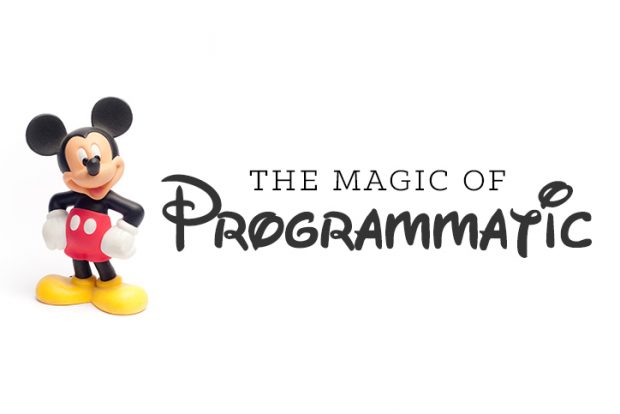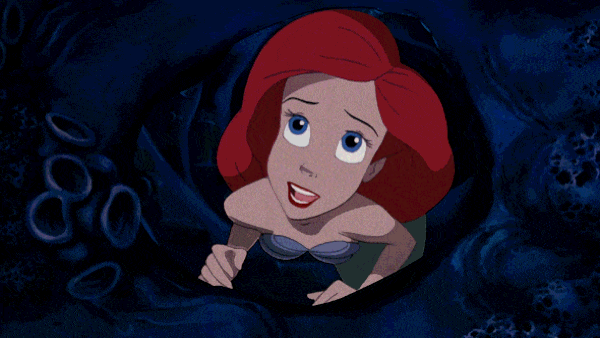Nebo’s Guide to Programmatic Advertising … Disneyfied

From the inception of the first banner ad to today’s AI chatbots, digital advertisers have had to continually adapt to changing business demands, new media technologies, disruptive mediums and of course, increasingly savvy audiences. The latest trend in our ever-evolving industry? Programmatic advertising, aptly named the “future of digital marketing.”
Programmatic ad spend is estimated to hit $20 billion this year in the U.S. alone and reach $38.5 billion by the end of 2020, as cited in Business Insider. But while the numbers continue to skyrocket, advertisers continue to be mystified by programmatic advertising. In fact, nearly 41% of marketers admit they are either unaware or lack understanding of programmatic ad buying. Let our programmatic advertising guide help clear things up. From The Little Mermaid to Inside Out, we’ll use Disney-inspired examples to simplify this so-called programmatic revolution, as well as identify the next steps in finding the right programmatic partner for you.
What is Programmatic Advertising?
Programmatic advertising is the automation of buying, placing and optimizing media inventory. Think of it as a less extreme version of life aboard the Axiom spaceship in Wall-E, in which nearly every aspect of human life is automated by technology. Essentially, programmatic advertising relies on machines to buy ads rather than on more expensive and less reliable human ad buyers and salespeople. The use of programming and machine automation allow advertisers to be more efficient, both in cost and execution. Quite frankly, it’s smarter, better advertising.

Credit: Disney Pixar via Tenor Gif Keyboard
While automated ad buying is effective, it is important to keep in mind that automation does not — and will never — replace human advertisers. We learn at the end of Wall-E that humans, not machines, ultimately need to run the show. Likewise, agencies and specialists are still very much needed for that human touch for overarching strategies, creative direction and more.
It is also important to keep in mind that programmatic advertising encompasses more than just display banners, but social, mobile and video placements as well. In fact, programmatic is slowly making its way toward TV, streaming and audio ads. But for this 101 guide, we’ll just focus on programmatic display.
How Does Programmatic Advertising Work?
A common misconception is that programmatic advertising is synonymous with real-time bidding, (RTB) and while one of these things is like the other, they are not the same. Programmatic advertising refers to the automation of ad buying; RTB, on the other hand, is a type of programmatic advertising — very much an “every square is a rectangle, but not every rectangle is a square” type of scenario. Since RTB is most commonly used for programmatic advertising, we’ll dive into the details of how it works in this section.
Real-time bidding is conducted during the milliseconds it takes for a site to load, commonly through an open auction. There are two main parties in an auction: the publishers who supply the ad inventory and the advertisers who want to advertise on the publisher’s website.
Think of publishers and advertisers as Lady and the Tramp — two dogs from different worlds on separate sides of the table. On the publisher’s side, there are Supply Side Platforms (SSP) that allow publishers to manage their advertising inventory, fill it with ads and receive revenue. On the other side, there are Demand Side Platforms (DSP) which facilitate the ad bidding, allowing advertisers to purchase ads. In conjunction with DSPs are Demand Management Platforms (DMP), which are centralized databases, or warehouses, that house multiple data sources. DMPs store and analyze the data to generate audience segments; in turn, this informs the buy that is executed through the DSP.

Credit: Disney via Giphy
Lady and the Tramp meet over a romantic plate of spaghetti and meatballs, but in the case of a RTB auction, the SSPs and DSPs meet in the ad exchange, where the auction actually takes place. Then, there’s the kiss. The highest bid wins the auction and the advertiser's ad server sends the creative to the browser. Keep in mind, this is all occurring in milliseconds. That’s Lightning McQueen fast.
Why Use Programmatic Advertising?
Narrow Targeting
Display started as a broadcast medium similar to its traditional counterparts: print, TV and radio. Advertisers initially followed a “spray-and-pray” model, shelling out impressions to anyone and everyone in the hopes that the right person will be targeted. This was both inefficient and a waste of advertising dollars. As digital marketing became the norm and data became more accessible, marketers moved toward today’s more informed targeting, leveraging numerous data points for demographic, interest and topic targeting. However, while this targeting is more effective, it still lacks precision, as these audiences rely on assumptions and stereotypes.
Think about it this way. Just because Ariel was born a mermaid under the sea, doesn’t mean she didn’t want to be where the people are; to see them, to see ’em dancing. Similarly, just because a large part of your target audience belongs to a certain affinity or demographic, it does not mean all members of that respective audience are interested in your brand. How can we efficiently reach the Ariels of the world?

Credit: Disney via Buzzfeed
Enter programmatic. Rather than using maybe a hundred data points to identify general audiences, programmatic advertising analyzes millions of data touch points in order to target users on an individual level (however not with any personally identifiable information — data privacy is a conversation for another blog post). The opportunity to combine a multitude of data sets from first, second, third and even offline data sources has granted advertisers the unprecedented ability to connect data to their ad placements and targeting in real time. We can now serve ads to those one-of-a-kind mermaids, those who wish to be out of the sea and part of our world.
Expanded Inventory & Unique Capabilities
Smaller advertisers and brands may be content with managing their display campaigns within the Google Display Network (GDN). After all, they have access to almost two million websites. But not all ad inventory is opted in to the GDN; if fact, most isn’t. Think of it this way: if Princess Jasmine’s palace represents the GDN, then everywhere outside of the palace represents the potential ad placements available to advertisers. Talk about a whole new world.
Additionally, there are unique targeting capabilities specific to working with programmatic partners that Google AdWords doesn’t provide. Mobile geo-fencing and search-powered audiences are just some of the capabilities out there — shining, shimmering, splendid — beyond the GDN.

Credit: Disney via WiffleGif
Concerns with Programmatic Advertising
Like with all digital advertising, programmatic ads are susceptible to ad fraud. And while ad fraud is nothing new (check out Bloomberg’s article on click fraud published way back in 2006) it is becoming more prevalent among programmatic advertising, mainly due to the way the ads are bought and sold in real time.
Refer back to programmatic advertising’s key strengths: advanced data targeting paired with access to an expansive ad inventory across millions of publishers. Pair these strengths with the frequently-used RTB’s open auction and the result is the near impossibility of identifying where and when each individual ad appears. Undoubtedly, this has led to critical concerns surrounding ad viewability and brand safety.
Ad Viewability
If a Disney protagonist doesn’t have an animal sidekick, is she really a Disney princess? Similarly, if an online ad isn’t viewable, is it really an ad? And do advertisers still have to pay for it? It is estimated that half of online ads aren’t even seen by real users. Considering that most programmatic buys are charged on a cost-per-impression (CPM) basis, ad viewability is a significant metric in programmatic advertising.

Credit: Disney via GoodReads
Fraudulent ad impressions commonly come from non-human traffic, such as from bots that mimic human activity to trick advertisers into serving an impression. Untrustworthy publishers can also be at fault here, such as those who purchase bot traffic from third-party sources in order to drive more pageviews (more site traffic equals more revenue). Fraudulent ad impressions can also come from human traffic, such as in the case of ad stacking, in which ads are placed behind each other so that only the top ad is visible, but all ads are counted as an impression.
Brand Safety
In today’s political landscape, many brands are hypersensitive to being associated with content that is toxic or polarizing, much less down-right inappropriate. Earlier this spring, an estimated 5% of Youtube’s advertisers left the platform over concerns their ads were being shown alongside extremist content. If even the almighty Google’s ad inventory is questionable, you can only imagine advertisers’ concerns among the open programmatic ad exchange.
Preventing Ad Fraud
Every Disney movie has a villain manifested in some shape or form, but that never prevents our beloved protagonists from getting their happily ever after. While ad fraud is a significant barrier to programmatic advertisers, as digital marketers, it is our responsibility to remain vigilant toward fraud to protect the brands we represent, for both brand safety and ad viewability. This can be done by ensuring the necessary steps are taken when engaging in a programmatic buy.
- Blacklists: Every advertiser should have an account-wide blacklist consisting of platforms or websites that have historically been suspected of bot traffic or undesired content. This list should be updated regularly. If working with a programmatic partner, demand transparency into this list. (See more about partner transparency in the following section.)
- Third-Party Vendors: Look into partners that specialize in ad fraud detection and prevention. Companies like Integral Ad Science offer advanced technology designed to reduce poor traffic.
- Active Monitoring: It is important to consistently audit your campaigns for signs of ad fraud. Looks for abnormal spikes in metrics and tie back performance to first-party data. If something looks too good to be true, it most likely is.

Credit: Disney via Rebloggy
How to Find the Right Programmatic Model
When engaging in a programmatic buy, there are two models commonly presented to advertisers: managed service and self service. Some programmatic partners offer one, some offer the other, and others offer a combination of the two. It is important to take into consideration your company’s resources when identifying which is the best model.
With managed service, the control lies with the programmatic partner. Their media specialists run and optimize campaigns on behalf of the brand or agency. Think of these programmatic media specialists as the five personas that influence Riley’s actions in the movie Inside Out. In a managed service model, they pull the levers. But that does not mean that the advertiser is completely hands-off in managing the programmatic buy, especially in the case of agency-client relationships. In a client’s eyes, the agency is Riley. The outside world doesn’t see the five personas in her mind’s headquarters; Riley’s actions are her own. Similarly, while programmatic partners manage the day-to-day ad buying, agencies are ultimately responsible for the performance of the campaign. Another thing to keep in mind is the markup in cost, since the media buying and management is outsourced to a programmatic partner.

Credit: Disney Pixar via Pinterest
When programmatic advertising first entered the landscape, managed service was the preferred method of programmatic buying for advertisers. However, as advertisers have become more aware of rising issues such as ad fraud and the lack of transparency in programmatic buying, they’ve started to take on self-service models, bringing programmatic advertising in house.
Regardless of the model chosen, advertisers should be vigilant and demand transparency from their programmatic partners. Ask them questions like:
- What is your core offering and how does it differ from others in the market?
- What data do you have access to? What proprietary data, if any, do you own? Which third-party data providers do you partner with? How often are data sources refreshed?
- What steps will be taken to safeguard my brand? How do you detect ad ad fraud and what process are set in place to prevent it? What websites will my ads be shown on?
- What services are offered in terms of initial onboarding and ongoing support? What does the account management team look like? What is the optimization process like?
- What are your reporting capabilities? Where is the bulk of my traffic coming from?
Looking Toward the Future of Programmatic
It has only been around for five years, but programmatic advertising has already made a significant impact on our industry. And while there have been growing pains for programmatic, it’s getting smarter, and marketers are getting smarter with it. Programmatic is a magical world, and it is undoubtedly the direction our industry is headed.
Comments
Add A Commentremove ads from children's cartoons, this is not normal